[November-2020]Real Exam Questions-Braindump2go AZ-400 VCE and PDF AZ-400 229Q Download[Q241-Q261]
2020/November Latest Braindump2go AZ-400 Exam Dumps with PDF and VCE Free Updated Today! Following are some new AZ-400 Real Exam Questions! QUESTION 241
You have an existing project in Azure DevOps.
You plan to integrate GitHub as the repository for the project.
You need to ensure that Azure Pipelines runs under the Azure Pipelines identity.
Which authentication mechanism should you use? A. personal access token (PAT)
B. GitHub App
C. Azure Active Directory (Azure AD)
D. OAuth Answer: B
Explanation:
GitHub App uses the Azure Pipelines identity.
Incorrect Answers:
A: Personal access token and OAuth use your personal GitHub identity.
Reference:
https://docs.microsoft.com/en-us/azure/devops/pipelines/repos/github 1 QUESTION 242
You plan to provision a self-hosted Linux agent.
Which authentication mechanism should you use to register the self-hosted agent? A. personal access token (PAT)
B. SSH key
C. Alternate credentials
D. certificate Answer: A
Explanation:
Note: PAT Supported only on Azure Pipelines and TFS 2017 and newer. After you choose PAT, paste the PAT token you created into the command prompt window. Use a personal access token (PAT) if your Azure DevOps Server or TFS instance and the agent machine are not in a trusted domain. PAT authentication is handled by your Azure DevOps Server or TFS instance instead of the domain controller.
Reference:
https://docs.microsoft.com/en-us/azure/devops/pipelines/agents/v2-linux 2 QUESTION 243
You are building a Microsoft ASP.NET application that requires authentication.
You need to authenticate users by using Azure Active Directory (Azure AD).
What should you do first? A. Assign an enterprise application to users and groups
B. Create an app registration in Azure AD
C. Configure the application to use a SAML endpoint
D. Create a new OAuth token from the application
E. Create a membership database in an Azure SQL database Answer: B
Explanation:
Register your application to use Azure Active Directory. Registering the application means that your developers can use Azure AD to authenticate users and request access to user resources such as email, calendar, and documents.
Reference:
https://docs.microsoft.com/en-us/azure/active-directory/manage-apps/developer-guidance-for-integrating-applications 3 QUESTION 244
You plan to create in Azure DevOps. Multiple developers will work on the project. The developers will work offline frequently and will require access to the full project history while they are offline.
Which version control solution should you use? A. Team Foundation Version Control
B. Git
C. TortoiseSVN
D. Subversion Answer: B
Explanation:
Git history: File history is replicated on the client dev machine and can be viewed even when not connected to the server. You can view history in Visual Studio and on the web portal.
Note: Azure Repos supports two types of version control: Git and Team Foundation Version Control (TFVC).
Incorrect Answers:
A: Team Foundation Version Control: File history is not replicated on the client dev machine and so can be viewed only when you're connected to the server.
Reference:
https://docs.microsoft.com/en-us/azure/devops/repos/tfvc/comparison-git-tfvc 4 QUESTION 245
You have the following Azure policy.
You assign the policy to the Tenant root group.
What is the effect of the policy? A. prevents all http traffic to existing Azure Storage accounts
B. ensures that all traffic to new Azure Storage accounts is encrypted
C. prevents HTTPS traffic to new Azure Storage accounts when the accounts are accessed over the Internet
D. ensures that all data for new Azure Storage accounts is encrypted at rest Answer: B
Explanation:
Denies non HTTPS traffic. QUESTION 246
You have a build pipeline in Azure Pipelines that uses different jobs to compile an application for 10 different architectures.
The build pipeline takes approximately one day to complete.
You need to reduce the time it takes to execute the build pipeline.
Which two actions should you perform? Each correct answer presents part of the solution.
NOTE: Each correct selection is worth one point. A. Move to a blue/green deployment pattern
B. Create a deployment group
C. Increase the number of parallel jobs
D. Reduce the size of the repository
E. Create an agent pool Answer: CE
Explanation:
Question: I need more hosted build resources. What can I do?
Answer: The Azure Pipelines pool provides all Azure DevOps organizations with cloud-hosted build agents and free build minutes each month. If you need more Microsoft-hosted build resources, or need to run more jobs in parallel, then you can either:
Host your own agents on infrastructure that you manage.
Buy additional parallel jobs.
Reference:
https://docs.microsoft.com/en-us/azure/devops/pipelines/agents/pools-queues 5 QUESTION 247
You are creating a build pipeline in Azure Pipelines.
You define several tests that might fail due to third-party applications.
You need to ensure that the build pipeline completes successfully if the third-party applications are unavailable.
What should you do? A. Configure the build pipeline to use parallel jobs
B. Configure flaky tests
C. Increase the test pass percentage
D. Add the Requirements quality widget to your dashboard Answer: D
Explanation:
Requirements traceability is the ability to relate and document two or more phases of a development process, which can then be traced both forward or backward from its origin. Requirements traceability help teams to get insights into indicators such as quality of requirements or readiness to ship the requirement.
A fundamental aspect of requirements traceability is association of the requirements to test cases, bugs and code changes.
Reference:
https://docs.microsoft.com/en-us/azure/devops/pipelines/test/requirements-traceability 6 QUESTION 248
Your company is building a new solution in Java.
The company currently uses a SonarQube server to analyze the code of .NET solutions.
You need to analyze and monitor the code quality of the Java solution.
Which task types should you add to the build pipeline? A. Gradle
B. Chef
C. Grunt
D. Gulp Answer: A
Explanation:
Prepare Analysis Configuration task, to configure all the required settings before executing the build.
This task is mandatory.
In case of .NET solutions or Java projects, it helps to integrate seamlessly with MSBuild, Maven and Gradle tasks.
Reference:
https://docs3.sonarqube.org/latest/analysis/scan/sonarscanner-for-azure-devops/ 7 QUESTION 249
You are designing a configuration management solution to support five apps hosted on Azure App Service. Each app is available in the following three environments: development, test, and production.
You need to recommend a configuration management solution that meets the following requirements:
- Supports feature flags
- Tracks configuration changes from the past 30 days
- Stores hierarchically structured configuration values
- Controls access to the configurations by using role-based access control (RBAC) permission
- Stores shared values as key/value pairs that can be used by all the apps
Which Azure service should you recommend as the configuration management solution? A. Azure Cosmos DB
B. Azure App Service
C. Azure App Configuration
D. Azure Key Vault Answer: C
Explanation:
The Feature Manager in the Azure portal for App Configuration provides a UI for creating and managing the feature flags that you use in your applications.
App Configuration offers the following benefits:
A fully managed service that can be set up in minutes
Flexible key representations and mappings
Tagging with labels
Point-in-time replay of settings
Dedicated UI for feature flag management
Comparison of two sets of configurations on custom-defined dimensions
Enhanced security through Azure-managed identities
Encryption of sensitive information at rest and in transit
Native integration with popular frameworks
App Configuration complements Azure Key Vault, which is used to store application secrets.
Reference:
https://docs.microsoft.com/en-us/azure/azure-app-configuration/overview 8 QUESTION 250
You have a containerized solution that runs in Azure Container Instances. The solution contains a frontend container named App1 and a backend container named DB1. DB1 loads a large amount of data during startup.
You need to verify that DB1 can handle incoming requests before users can submit requests to App1.
What should you configure? A. a liveness probe
B. a performance log
C. a readiness probe
D. an Azure Load Balancer health probe Answer: C
Explanation:
For containerized applications that serve traffic, you might want to verify that your container is ready to handle incoming requests. Azure Container Instances supports readiness probes to include configurations so that your container can't be accessed under certain conditions.
Incorrect Answers:
A: Containerized applications may run for extended periods of time, resulting in broken states that may need to be repaired by restarting the container. Azure Container Instances supports liveness probes so that you can configure your containers within your container group to restart if critical functionality is not working.
Reference:
https://docs.microsoft.com/en-us/azure/container-instances/container-instances-readiness-probe 9 QUESTION 251
You have an Azure DevOps organization named Contoso.
You need to receive Microsoft Teams notifications when work items are updated.
What should you do? A. From Azure DevOps, configure a service hook subscription
B. From Microsoft Teams, configure a connector
C. From Microsoft Teams admin center, configure external access
D. From Microsoft Teams, add a channel
E. From Azure DevOps, install an extension Answer: A
Explanation:
Service hooks let you run tasks on other services when events happen in your Azure DevOps projects. For example, create a card in Trello when a work item is created or send a push notification to your team's mobile devices when a build fails. You can also use service hooks in custom apps and services as a more efficient way to drive activities when events happen in your projects.
Note: Service hook publishers define a set of events. Subscriptions listen for the events and define actions to take based on the event. Subscriptions also target consumers, which are external services that can run their own actions, when an event occurs.
Reference:
https://docs.microsoft.com/en-us/azure/devops/service-hooks/overview 10 QUESTION 252
You have an Azure DevOps organization named Contoso and an Azure subscription. The subscription contains an Azure virtual machine scale set named VMSS1 that is configured for autoscaling.
You use Azure DevOps to build a web app named App1 and deploy App1 to VMSS1. App1 is used heavily and has usage patterns that vary on a weekly basis.
You need to recommend a solution to detect an abnormal rise in the rate of failed requests to App1. The solution must minimize administrative effort.
What should you include in the recommendation? A. the Smart Detection feature in Azure Application Insights
B. the Failures feature in Azure Application Insights
C. an Azure Service Health alert
D. an Azure Monitor alert that uses an Azure Log Analytics query Answer: A
Explanation:
After setting up Application Insights for your project, and if your app generates a certain minimum amount of data, Smart Detection of failure anomalies takes 24 hours to learn the normal behavior of your app, before it is switched on and can send alerts.
Reference:
https://docs.microsoft.com/en-us/azure/azure-monitor/app/proactive-failure-diagnostics 11 QUESTION 253
You create an alert rule in Azure Monitor as shown in the following exhibit.

Which action will trigger an alert? A. a failed attempt to delete the ASP-9bb7 resource
B. a change to a role assignment for the ASP-9bb7 resource
C. a successful attempt to delete the ASP-9bb7 resource
D. a failed attempt to scale up the ASP-9bb7 resource Answer: A QUESTION 254
You have a web app hosted on Azure App Service. The web app stores data in an Azure SQL database.
You need to generate an alert when there are 10,000 simultaneous connections to the database. The solution must minimize development effort.
Which option should you select in the Diagnostics settings of the database? A. Send to Log Analytics
B. Stream to an event hub
C. Archive to a storage account Answer: A
Explanation:
ENABLE DIAGNOSTICS TO LOG ANALYTICS
This configuration is done PER DATABASE
1. Click on Diagnostics Settings and then Turn On Diagnostics 
2. Select to Send to Log Analytics and select the Log Analytics workspace. For this sample I will selected only Errors 
Reference:
https://techcommunity.microsoft.com/t5/azure-database-support-blog/azure-sql-db-and-log-analytics-better-together-part-1/ba-p/794833 12 QUESTION 255
Drag and Drop Question
You have an Azure DevOps release pipeline as shown in the following exhibit.

You need to complete the pipeline to configure OWASP ZAP for security testing.
Which five Azure CLI tasks should you add in sequence? To answer, move the tasks from the list of tasks to the answer area and arrange them in the correct order.

Answer:

Explanation:
Defining the Release Pipeline
Once the application portion of the Release pipeline has been configured, the security scan portion can be defined. In our example, this consists of 8 tasks, primarily using the Azure CLI task to create and use the ACI instance (and supporting structures).
Otherwise specified, all the Azure CLI tasks are Inline tasks, using the default configuration options.
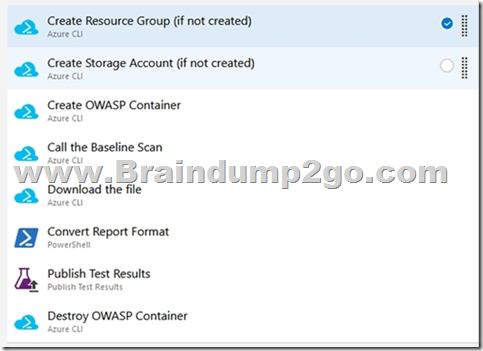
Reference:
https://devblogs.microsoft.com/premier-developer/azure-devops-pipelines-leveraging-owasp-zap-in-the-release-pipeline/ 13 QUESTION 256
Hotspot Question
You company uses a Git source-code repository.
You plan to implement Gitflow as a workflow strategy.
You need to identify which branch types are used for production code and preproduction code in the strategy.
Which branch type should you identify for each code type? To answer, select the appropriate options in the answer area.
NOTE: Each correct selection is worth one point.

Answer:

Explanation:
Box 1: Master
The Master branch contains production code. All development code is merged into master in sometime.
Box 2: Develop
The Develop branch contains pre-production code. When the features are finished then they are merged into develop.
Incorrect Answers:
During the development cycle, a variety of supporting branches are used:
Feature branches are used to develop new features for the upcoming releases. May branch off from develop and must merge into develop.
Reference:
https://medium.com/@patrickporto/4-branching-workflows-for-git-30d0aaee7bf 14 QUESTION 257
Drag and Drop Question
You have an Azure subscription that contains a resources group named RG1. RG1 contains the following resources:
- Four Azure virtual machines that run Windows Server and have Internet Services (IIS) installed.
- SQL Server on an Azure virtual machine.
- An Azure Load Balancer.
You need to deploy an application to the virtual machines in RG1 by using Azure Pipelines.
Which four actions should you perform in sequence? To answer, move the appropriate actions from the list of actions to the answer area and arrange them in the correct order.
NOTE: More than one order of answer choices is correct. You will receive credit for any of the correct orders you select.
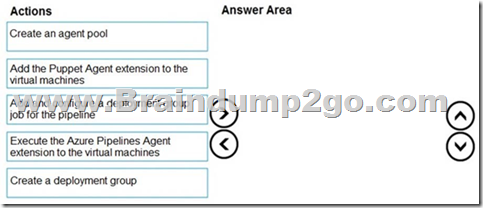
Answer:
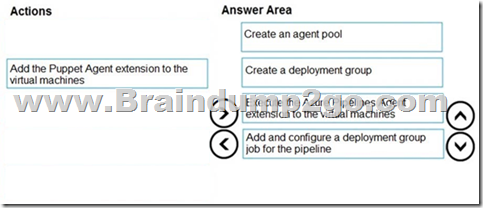
Explanation:
Step 1: Create an agent pool
Azure Pipelines provides a pre-defined agent pool named Azure Pipelines with Microsoft-hosted agents.
Step 2: Create a deployment group
Deployment groups make it easy to define logical groups of target machines for deployment, and install the required agent on each machine.
Step 3: Execute the Azure Pipelines Agent extension to the virtual machines Install the Azure Pipelines Agent Azure VM extension
Step 4: Add and configure a deployment group job for the pipeline Tasks that you define in a deployment group job run on some or all of the target servers, depending on the arguments you specify for the tasks and the job itself.
Reference:
https://docs.microsoft.com/en-us/azure/devops/pipelines/release/deployment-groups/howto-provision-deployment-group-agents 15 QUESTION 258
Hotspot Question
You have an application named App1 that has a custom domain of app.contoso.com.
You create a test in Azure Application Insights as shown in the following exhibit.
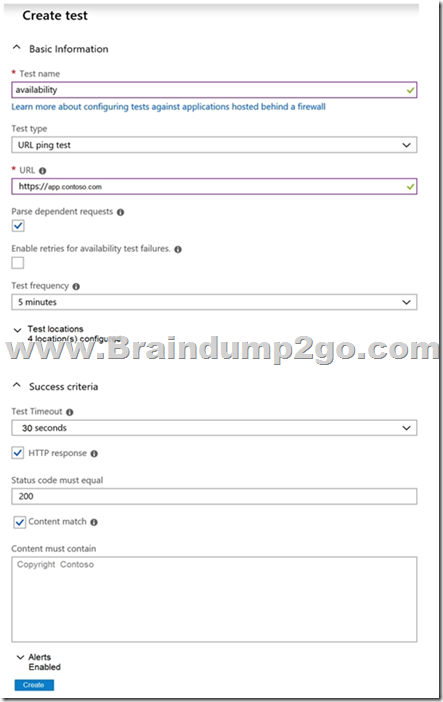
Use the drop-down menus to select the answer choice that completes each statement based on the information presented in the graphic.
NOTE: Each correct selection is worth one point.
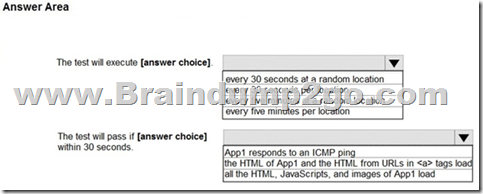
Answer:
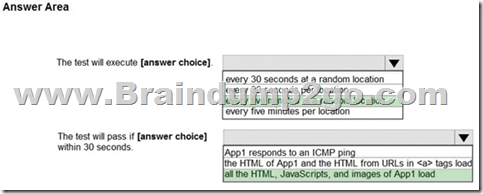
Explanation:
Box 1: every five minutes at a random location
Test frequency: Sets how often the test is run from each test location. With a default frequency of five minutes and five test locations, your site is tested on average every minute.
Box 2:
Parse dependent requests: Test requests images, scripts, style files, and other files that are part of the web page under test. The recorded response time includes the time taken to get these files. The test fails if any of these resources cannot be successfully downloaded within the timeout for the whole test.
Reference:
https://docs.microsoft.com/en-us/azure/azure-monitor/app/monitor-web-app-availability 16 QUESTION 259
Hotspot Question
You use Azure Pipelines to manage the build and deployment of apps.
You are planning the release strategies for a new app.
You need to choose strategies for the following scenarios:
- Releases will be made available to users who are grouped by their tolerance for software faults.
- Code will be deployed to enable functionality that will be available in later releases of the app.
- When a new release occurs, the existing deployment will remain active to minimize recovery time if a return to the previous version is required.
Which strategy should you choose for each scenario? To answer, select the appropriate options in the answer area.
NOTE: Each correct selection is worth one point.
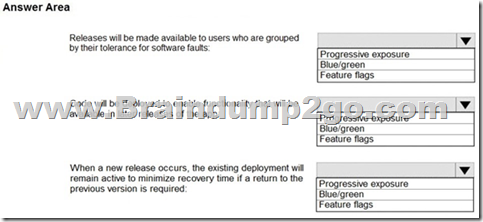
Answer:
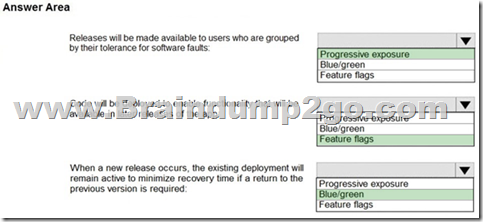
Explanation:
Box 1: Progressive exposure
Continuous Delivery may sequence multiple deployment "rings" for progressive exposure (also known as "controlling the blast radius"). Progressive exposure groups users who get to try new releases to monitor their experience in "rings." The first deployment ring is often a "canary" used to test new versions in production before a broader rollout. CD automates deployment from one ring to the next and may optionally depend on an approval step, in which a decision maker signs off on the changes electronically. CD may create an auditable record of the approval in order to satisfy regulatory procedures or other control objectives.
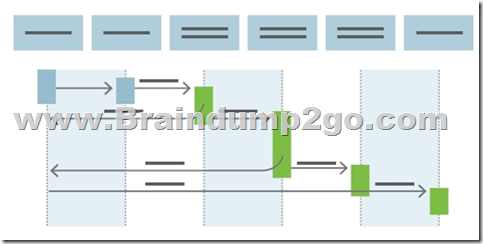
Box 2: Feature flags
Feature flags support a customer-first DevOps mindset, to enable (expose) and disable (hide) features in a solution, even before they are complete and ready for release.
Box 3: Blue/green
Blue/green deployments which means that instead of replacing the previous version (here we refer to this version as blue), we bring up the new version (here referred to as the green version) next to the existing version, but not expose it to the actual users right away. On the condition of having successfully validated that the green version works correctly, we will promote this version to the public version by changing the routing configuration without downtime. If something is wrong with the green version we can revert back without users every noticing interruptions.
Reference:
https://docs.microsoft.com/en-us/azure/devops/learn/what-is-continuous-delivery 17
https://docs.microsoft.com/en-us/azure/devops/migrate/phase-features-with-feature-flags 18
https://medium.com/@denniszielke/continuous-kubernetes-blue-green-deployments-on-azure-using-nginx-appgateway-or-trafficmanager-4490bce29cb 19 QUESTION 260
Drag and Drop Question
You have a project in Azure DevOps.
You need to associate an automated test to a test case.
Which three actions should you perform in sequence? To answer, move the appropriate actions from the list of actions to the answer area and arrange them in the correct order.
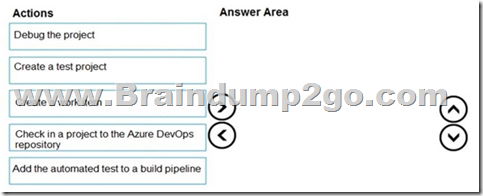
Answer:
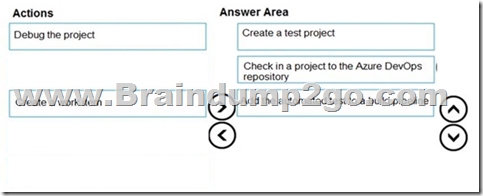
Explanation:
The process to associate an automated test with a test case is:
1. Create a test project containing your automated test. What types of tests are supported?
2. Check your test project into an Azure DevOps or Team Foundation Server (TFS) repository.
3. Create a build pipeline for your project, ensuring that it contains the automated test. What are the differences if I am still using a XAML build?
4. Use Visual Studio Enterprise or Professional 2017 or a later version to associate the automated test with a test case as shown below. The test case must have been added to a test plan that uses the build you just defined.
Reference:
https://docs.microsoft.com/en-us/azure/devops/test/associate-automated-test-with-test-case 20 QUESTION 261
Drag and Drop Question
Your company has two virtual machines that run Linux in a third-party public cloud.
You plan to use the company's Azure Automation State Configuration implementation to manage the two virtual machines and detect configuration drift.
You need to onboard the Linux virtual machines.
You install PowerShell Desired State Configuration (DSC) on the virtual machines, and then run register.py
Which three actions should you perform next in sequence? To answer, move the actions from the list of actions to the answer area and arrange them in the correct order.

Answer:
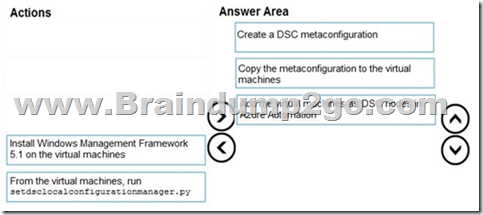
Explanation:
Step 1: Create a DSC metaconfiguration
Load up the DSC Configuration into Azure Automation.
Step 2: Copy the metaconfiguration to the virtual machines.
Linking the Node Configuration to the Linux Host
Step 3: Add the virtual machines as DSC nodes in Azure Automation. go to DSC Nodes, select your node, and then click Assign node configuration. This step assigns the DSC configuration to the Linux machine.
Next up will be to link the node configuration to the host. Go to the host and press the "Assign node..."- button. Next up you can select your node configuration.
Resources From:1.2020 Latest Braindump2go AZ-400 Exam Dumps (PDF & VCE) Free Share:
https://www.braindump2go.com/az-400.html 2.2020 Latest Braindump2go AZ-400 PDF and AZ-400 VCE Dumps Free Share:
https://drive.google.com/drive/folders/1kLhX5N_Pt_noAKZD50xUpnSEA5Tt62TZ?usp=sharing 3.2020 Free Braindump2go AZ-400 PDF Download:
https://www.braindump2go.com/free-online-pdf/AZ-400-PDF-Dumps(241-253).pdf
https://www.braindump2go.com/free-online-pdf/AZ-400-VCE-Dumps(254-264).pdf Free Resources from Braindump2go,We Devoted to Helping You 100% Pass All Exams!
|




















